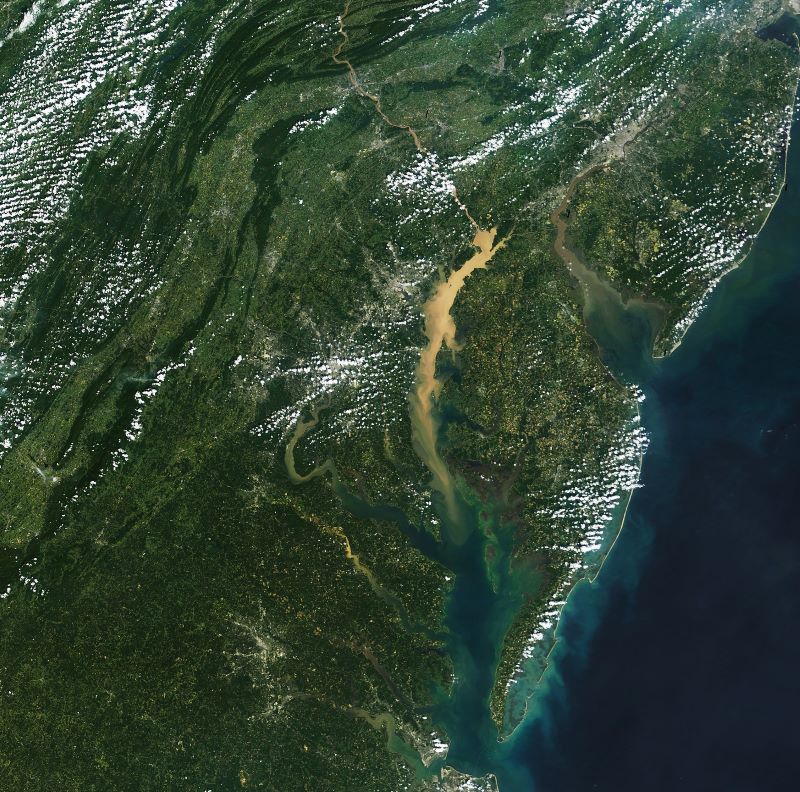
Chesapeake Bay
About the Chesapeake Bay
This unique estuary is the largest in the nation and third largest in the world. Its 64,000-square-mile watershed encompasses parts of six states – Delaware, Maryland, New York, Pennsylvania, Virginia, and West Virginia – and the District of Columbia.
In the Chesapeake Bay watershed there are more than 100,000 streams and rivers that eventually flow into the Bay. Everyone in the Bay watershed lives within a few minutes of one of these streams and rivers, which are like pipelines from our communities to the Bay.
The Bay and its watershed have remarkable ecological, economic, recreational, historic, and cultural value to the City of Alexandria and the region.

What Issues Affect the Chesapeake Bay?
Clean, healthy water is essential to the health of the plants and animals that live in the Chesapeake Bay and its rivers. Healthy water contains a balanced amount of nutrients, normal fluctuations in temperature, and plenty of dissolved oxygen so fish, crabs, and other aquatic life can breathe, and few suspended sediments so underwater plants receive enough sunlight to grow.
Any rain that does not evaporate or soak into the ground, but instead ponds and travels downhill is called stormwater. When rain falls on hard surfaces like roofs, driveways, parking lots, and streets, stormwater can’t naturally soak into the ground and runs off, creating stormwater runoff. Runoff from urban, agricultural, and industrial areas can contain nutrients, sediment, and chemicals. The City of Alexandria has adopted an Environmental Management Ordinance to help protect the Chesapeake Bay from pollution and urban runoff. The Bay is currently subject to several special state and federal regulations; the most important of which is the Chesapeake Bay Total Maximum Daily Load (TMDL).
The City is committed to protecting local streams, the Potomac River, and the Chesapeake Bay and will continue to search out innovative ways to meet the requirements of the Chesapeake Bay TMDL requirements.
Please visit the EPA Chesapeake Bay TMDL website to learn more about the Chesapeake Bay TMDL, including fact sheets, frequently asked questions, and video clips of recorded presentations.
Please visit the Virginia Department of Environmental Quality's Chesapeake Bay TMDL website to learn more about the Virginia WIP process.
Bay Cleanup Mandates
WHAT DOES THE CITY NEED TO DO TO MEET THE CHESAPEAKE BAY CLEANUP MANDATES?
The City’s TMDL pollution reduction requirement has been incorporated into the City’s 5-year MS4 permit, which includes the specific pollution reduction requirements that must be met in order to comply with the Bay TMDL. In order to meet the requirements of the Bay TMDL, the City will have three full five-year MS4 permit cycles to implement the required reductions (Phase I: 2013-2018; Phase II: 2018-2023; and Phase III: 2023-2028). Please visit the the Stormwater Infrastructure Projects page to learn about ongoing projects the City is working on to meet these cleanup mandates.
CHESAPEAKE BAY TMDL ACTION PLAN
The City completed a Chesapeake Bay TMDL Action Plan that details the means and methods to meet the Phase I (5%) target reductions for nitrogen, phosphorus and sediment from stormwater runoff that must be implemented no later than the end of the current 5-year MS4 permit period (June 30, 2018). The Draft Chesapeake Bay TMDL Phase I (5%) Action Plan was posted for public comment during June 2015. The comment-response table and the final Chesapeake Bay TMDL 5% Action Plan can be found below.
The Final Chesapeake Bay TMDL Phase 2 (40%) and Phase 3 (100%) Action Plans are posted below. Please send questions about the plan to MS4ProgramPlan@alexandriava.gov.
- Draft Bay TMDL Action Plan Comment-Response Table
- Chesapeake Bay TMDL Phase I (5%) Action Plan
- Chesapeake Bay TMDL Phase 2 (40%) Action Plan
- Chesapeake Bay TMDL Phase 3 (100%) Action Plan
Chesapeake Bay Preservation Plan & Eco-City Alexandria Environmental Action Plan
In October 2022, Alexandria City Council adopted the Alexandria Chesapeake Bay Preservation Plan. The Plan is a part of the City's Master Plan and an update to the 2001 Water Quality Management Supplement. The purpose of the Plan is to recognize the interdependency between people and their environment and to guide the City as it seeks to protect and restore its own numerous local waterways as well as the natural habitats of the Chesapeake Bay and Potomac River.